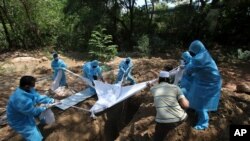China’s Guangzhou city, a port city of more than 13 million people, on Saturday ordered more restrictions due to a rise in COVID-19 cases that began in late May.
Of the 24 new cases of COVID-19 reported in China on Saturday, 11 were transmitted in Guangzhou province, where the city is located.
Authorities had imposed restrictions earlier in the week but sought additional limits on business and social activities. Authorities closed about a dozen subway stops, and the city’s Nansha district ordered restaurants to stop dine-in services and public venues, such as gyms, to temporarily close.
Officials in the districts of Nansha, Huadu and Conghua ordered all residents and any individuals who have traveled through their regions to be tested for COVID-19, the disease caused by the coronavirus, Reuters reported.
Also, Sinovac Biotech’s COVID-19 vaccine has been approved for emergency use for young people between the ages of 3 and 17, the company’s chairman, Yin Weidong, said on state television Friday. China’s current vaccination program is restricted to those 18 and older.
As Afghanistan attempts to beat back a surge in COVID-19 cases, it has received the news that the 3 million doses of vaccines it was expecting from the World Health Organization in April will not arrive until August, according to the Associated Press.
Afghan health ministry spokesman Ghulam Dastagir Nazari told AP that he has approached several embassies for help but has not received any vaccines. “We are in the middle of a crisis,” he said.
On Saturday, India’s health ministry reported 120,529 new COVID-19 cases in the previous 24 hours period, the lowest daily count of new infections in 58 days. More than 3,000 deaths were also recorded.
Britain’s Medicines and Healthcare products Regulatory Agency Friday approved the Pfizer-BioNTech COVID-19 vaccine for 12- to 15-year-olds.
The decision follows similar approvals by U.S. and European Union regulators.
Johns Hopkins Coronavirus Resource Center reported early Saturday more than 172 million global COVID infections. The U.S. has the most cases with 33.3 million, followed by India with 28.7 million and Brazil with nearly 17 million.
